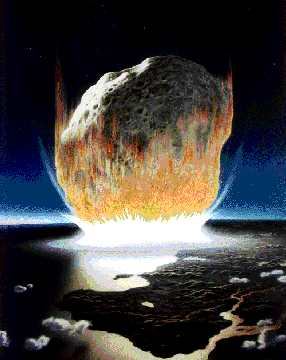![]()
![]()
| Figure 5: A Cosmic Impact is the Favoured Explanation for the End-Cretaceous Extinction |  |
There is a sudden disappearance of many life-forms at the end of the Cretaceous, including Velociraptor. The Cretaceous mass extinction event is second only to the end-Permian event in the number of species that disappeared. The animals lost in this extinction event include the dinosaurs, pterosaurs and large marine reptiles. Whole families of planktonic foraminifera, calcareous phytoplankton, bryozoans, and echinoderms disappeared. A cosmic impact is the favoured explanation for the end-Cretaceous extinction. The Cretaceous/Tertiary boundary horizon is marked by an unusually high concentration of the element iridium. The mineral coesite (high pressure form of quartz) also supports the evidence of a cosmic impact because it is not found at volcanic eruptions, and is considered an unequivocal indicator of a meteorite impact. The impact crater was likely off of the north coast of the Yucatan Peninsula.
|
|
|
|